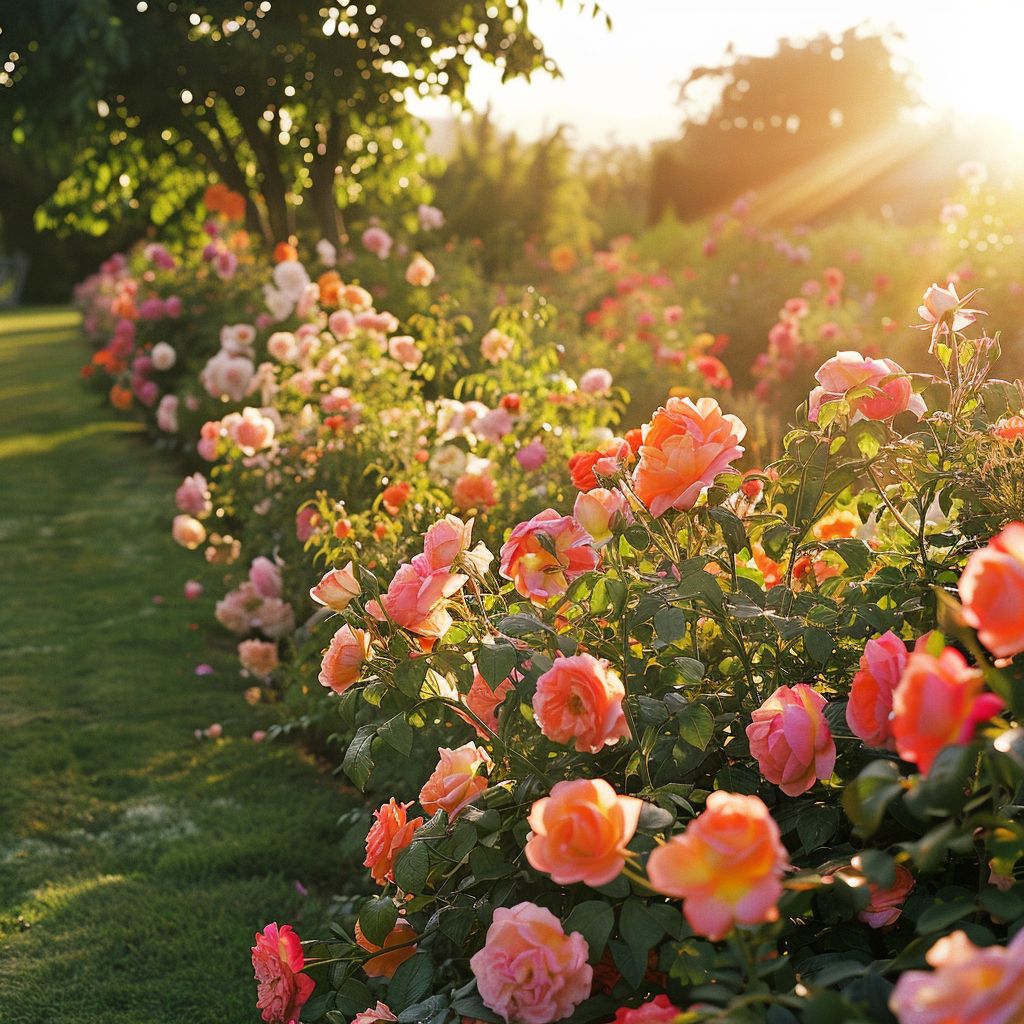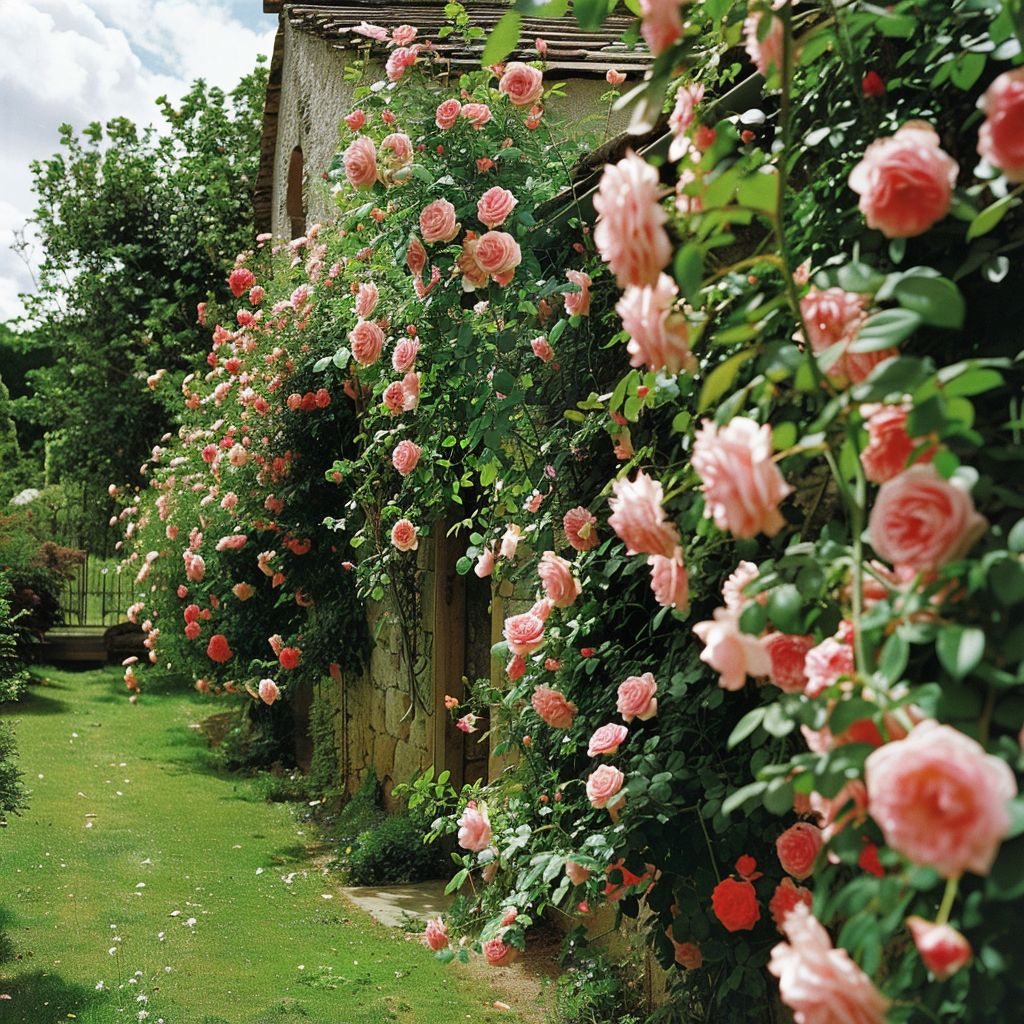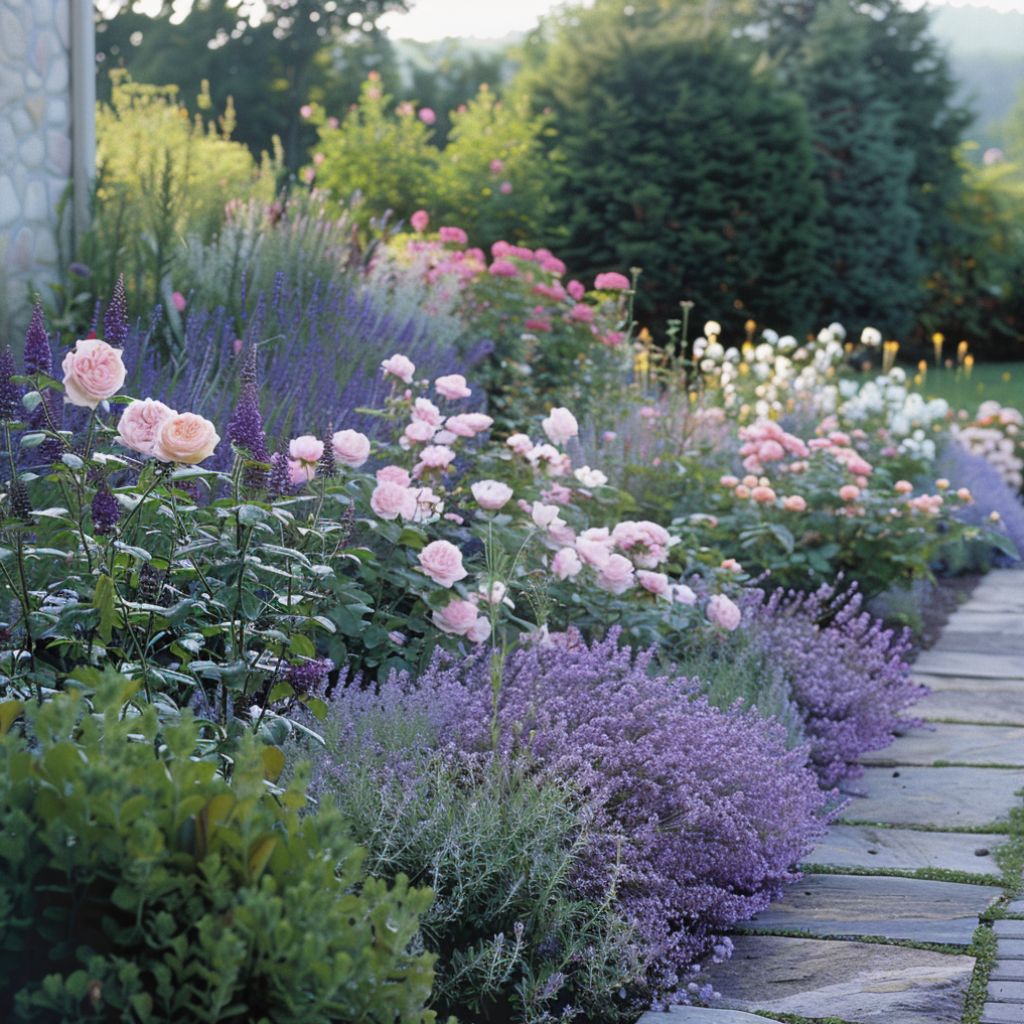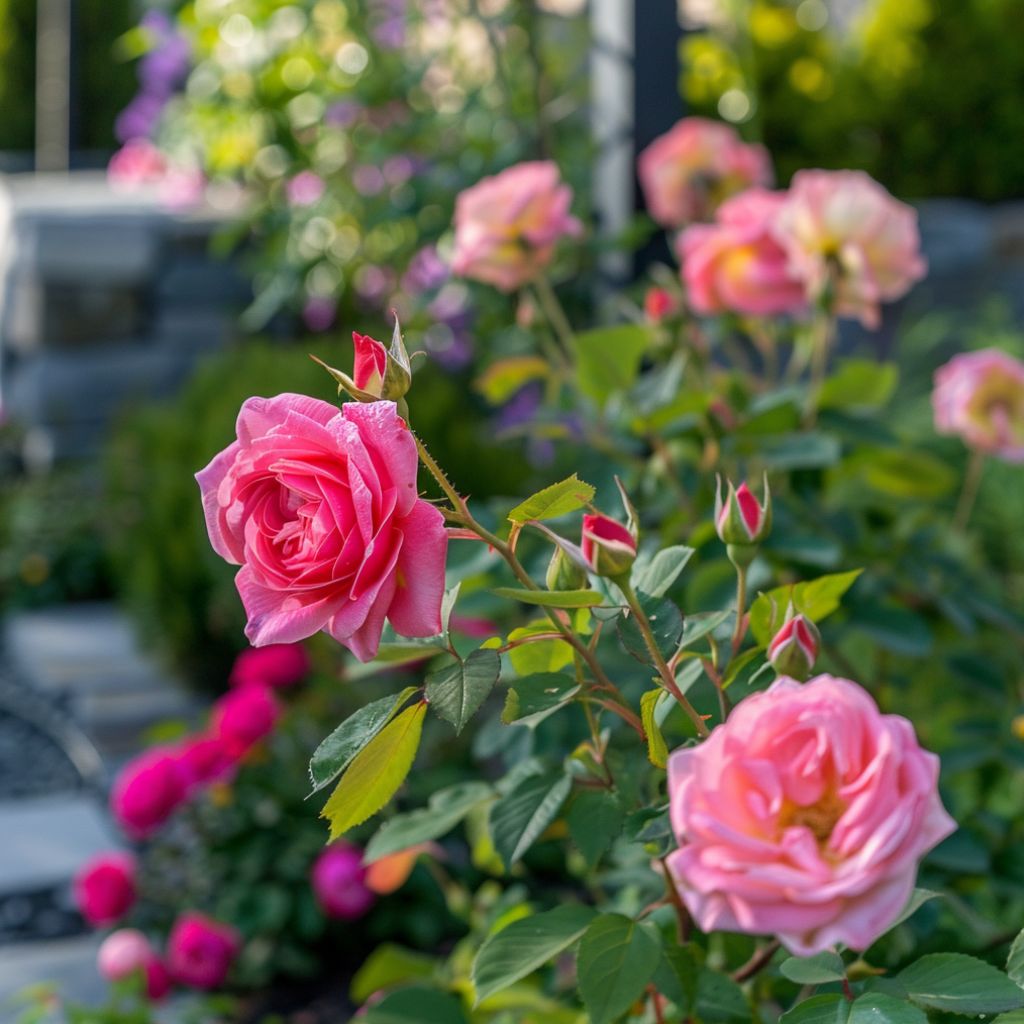Imagine stepping into your garden and being greeted by the enchanting fragrance and vibrant colours of roses. These timeless blooms, loved for their large flowers and divine scent, bring a touch of romance and elegance to any outdoor space.
Whether you envision classic symmetrical borders or prefer a more informal arrangement, there are countless ways to incorporate roses into your garden design.
From climbers gracefully adorning pergolas to pots on your patio, roses offer unparalleled versatility. You don’t need a formal rose garden to enjoy their beauty; with so many varieties available, there’s an option for almost every position in your garden.
Ready to transform your outdoor space? Let’s explore some inspiring rose garden ideas that will make your dream a reality.
Choosing the Right Location for Your Rose Garden
Picking the ideal spot is crucial for a thriving rose garden. Here are some key considerations to help you get started.
Factors to Consider: Light, Wind, and Soil
Light

Roses need plenty of sunlight to flourish. Aim for a location that gets over six hours of direct sun each day if you’re planting full sun varieties. For partial sun types, three to six hours will do. Morning sun is particularly important as it helps dry off dew and prevents diseases like powdery mildew.
Wind and Air Circulation
Good air circulation is vital for healthy roses. Plant them in open areas with ample space between them and other plants or structures. This helps avoid crowded conditions that can lead to disease. Keep roses away from shaded spots, especially those near dense foliage like Douglas fir trees.
Soil
Proper drainage is essential for rose health, especially in clay soils. Opt for soil that drains well to prevent waterlogging and root rot issues. Roses don’t fare well in clay soils that retain too much water; ensuring good drainage will keep their roots healthy.
By considering these factors—light, wind, and soil—you’ll set up your rose garden for success from the start.
Selecting Rose Varieties for Your Garden
Choosing the right roses can transform your garden into a stunning landscape. Consider factors like growth habit, fragrance, and foliage to find the perfect fit.
Popular Rose Types and Their Care Requirements

- Climbing Roses: Perfect for small spaces, climbing roses grow up structures like pergolas or trellises. They need regular pruning and support to keep their shape.
- Ramblers: Ideal for growing through trees, ramblers such as ‘Francis E. Lester’ are known for delicate flowers and lovely scents. Once established, they require minimal upkeep.
- Hybrid Teas: Known for large blooms, hybrid teas demand more care and are prone to diseases. Regular pruning and attention are essential for them to thrive.
Considering Climate and Hardiness Zones
Determine your climate zone before selecting rose varieties. Some roses fare better in specific climates due to their hardiness levels.
- Warm Climates: Choose heat-tolerant varieties that can withstand high temperatures without wilting.
- Cold Climates: Opt for hardy types that survive frost and extreme cold conditions without damage.
Knowing your zone helps you pick roses that will flourish with less effort on your part. Local nurseries often provide guidance on which varieties suit your area best.
Selecting appropriate roses based on these factors ensures a beautiful, thriving garden year-round.
Designing Your Rose Garden Layout
Planning your rose garden? Here are some layout ideas to get you started.
Formal Versus Informal Rose Gardens
Formal rose gardens feature symmetrical beds and geometric shapes. They often use single species of roses surrounded by clipped hedges. This style requires regular upkeep for a pristine look.
Informal rose gardens, like charming garden concepts, mix roses with other perennials. They have a jumbled, relaxed feel that’s easier to maintain but equally delightful.
Incorporating Paths and Walkways

Adding paths and walkways can enhance your garden’s functionality. Use gravel or brick paths to create easy access while enjoying the blooms.
Paths also help in dividing different sections of the garden. This makes it simpler to manage various plantings without disturbing others.
Combining Roses with Other Plants
Combining roses with other plants can elevate the beauty and health of your garden. By selecting plants that complement roses, you create a visually appealing and thriving space.
Best Companion Plants for Roses
- Herbs and Aromatic Plants: Herbs like scented geraniums, rue, feverfew, parsley, and thyme repel pests while adding fragrance to your rose garden. They improve the overall sensory experience.
- Perennials and Shrubs: Lavender, catmint, lady’s mantle, and tall growing pinks provide contrasting textures and colours that enhance roses’ visual appeal.

Tips for Layering Plants in a Rose Garden
Layering plants in your rose garden adds depth and interest. Place taller plants like climbing roses or ramblers at the back to add height. Use medium-sized shrubs in front to hide the base of taller roses while deterring aphids.
Consider underplanting with low-growing herbs or groundcover varieties for a fuller look. Choose companions with similar sun, water, and soil needs to simplify maintenance. This approach creates a balanced ecosystem where each plant supports the others.
By thoughtfully combining different types of plants around your roses, you achieve both aesthetic charm and healthier growth conditions for all garden inhabitants.
Innovative Planting Ideas
Transform your garden with creative rose planting techniques. Experiment with different setups to add charm and character to your outdoor space.
Using Roses as Hedges or Privacy Screens
Plant roses as natural dividers. Use rose trees, shrubs, or ground cover roses to form soft, natural hedges. Opt for neutral tones like white, blush, or yellow for a modern look. Knock Out roses are excellent due to their abundant flowers and low maintenance needs.
Creating a Vertical Display with Climbing Roses

Enhance vertical spaces using climbing roses. They can adorn arbors, pergolas, and trellises beautifully. Mix them with other climbers like clematis for a stunning effect. Choose varieties that thrive in shaded areas if needed; ‘Francis E. Lester’ is an ideal option with its pink blooms and musky scent.
Designing a Mixed Border with Roses
Combine Australian outdoor plants with roses for a vibrant mixed border. Pair them with perennials and aromatic herbs to create an appealing visual contrast and support garden health. Layer taller plants at the back and underplant with low-growing varieties for fullness. This approach adds depth and dimension to your garden layout.
By integrating these innovative ideas into your garden design, you’ll create stunning visuals while optimising space efficiently.
Maintaining Your Rose Garden
Careful maintenance is crucial for a thriving rose garden. Let’s dive into key practices to keep your roses in top shape.
Pruning Techniques for Healthy Growth

Prune hybrid tea roses hard down to 3 or 4 buds in March. Make sure the buds face outward to shape the bush like a goblet. In November, cut hybrid tea and floribunda roses down by about a third to prevent wind damage. Remove faded blooms regularly, encouraging more flowers throughout the season.
Soil and Nutrition Management
Use well-draining soil mixed with compost. This boosts nutrient availability and promotes healthy growth. Fertilise your roses in spring when new growth starts, using balanced fertilisers rich in nitrogen, phosphorus, and potassium. Repeat feeding every four to six weeks until late summer for continuous blooming.
Watering Essentials
Water newly planted roses every two or three days from March to May. Established ones need water once a week during this period. From June to September, water established roses weekly while newly planted ones need hydration every other day. Use around 5 litres for shrub roses and those in pots; climbing varieties require about 10 litres each time.
Pest and Disease Control
Spray against common issues like blackspot, mildew, and rust as needed. A product like Bronte Rose Defence can help manage pests effectively—just follow the packaging instructions closely.
Common Challenges and Solutions in Rose Gardening
Rose gardening can be incredibly rewarding, but it often presents a range of challenges. Here are some common issues and their solutions to help you keep your rose garden thriving.
Dealing with Pests and Diseases
- Aphids:
- Symptoms: You may notice distorted growth, weak stems, and sticky honeydew that attracts sooty mould.
- Solutions: Attract beneficial insects like ladybirds or lacewings to control aphid numbers. Use a mild mix of non-bio washing up liquid for an easy home remedy. Install bird boxes to draw birds that eat aphids.
- Black Spot:
- Symptoms: Look for dark purple-black spots on leaves and stems.
- Solutions: Remove infected leaves and stems immediately to stop reinfection. Mulch in late winter to reduce black spot risk next season. Choose disease-resistant varieties when planting new roses.
- Powdery Mildew:
- Symptoms: White powdery growth appears on leaves and buds.
- Solutions: Improve air circulation around plants by pruning excess foliage. Water at the base rather than overhead to keep leaves dry.
- Drought Stress:
- Roses need consistent moisture, especially during dry spells.
- Solutions: Water deeply once or twice a week rather than daily light watering. Add mulch around the base of plants to retain soil moisture.
- Frost Damage:
- Frost can harm tender rose shoots.
- Solutions: Cover roses with horticultural fleece during frosty nights. Move potted roses indoors or into sheltered areas if possible.
- Heat Stress:
- Prolonged heat can cause wilting and leaf scorch.
- Solutions: Provide temporary shade using garden fabric or umbrellas during peak heatwaves. Ensure adequate watering early in the morning before the sun intensifies.
Up next:
